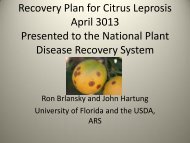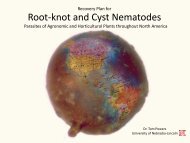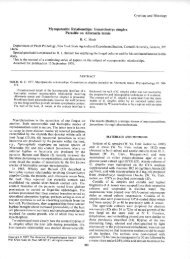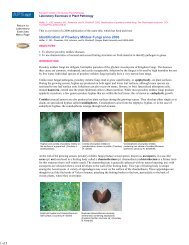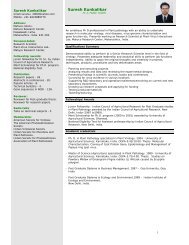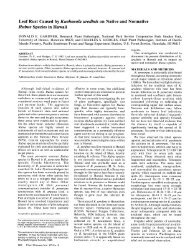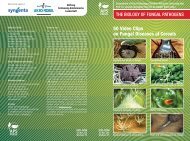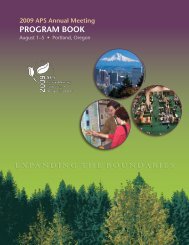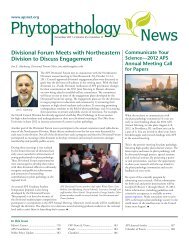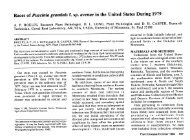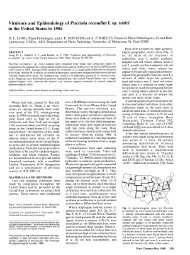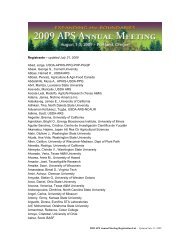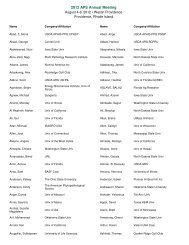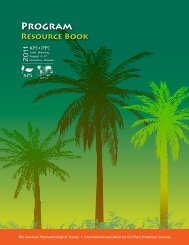view article - American Phytopathological Society
view article - American Phytopathological Society
view article - American Phytopathological Society
You also want an ePaper? Increase the reach of your titles
YUMPU automatically turns print PDFs into web optimized ePapers that Google loves.
from a lambda library of Ehg (isolate 713) plasmid DNA. A the plasmid pBE6. When conjugated into strain K60, pBE6<br />
7.5 kb fragment was further subcloned into pUCl18 plasmid in caused loss of both virulence and EPS production.<br />
both orientations. Both plasmids direct IAA biosynthesis in Mutagenesis of pBE6 with Tn3-GUS indicated a functional DNA<br />
transformed E. coli cells, as can be seen on TLC. Two new region of approximately 1.0 kb. The direction of<br />
proteins were shown to be made by these plasmids in a minicell transcription of the gene was determined; the 1.0 kb<br />
system. fragment encoded a protein of about 25.5 kDa in maxicell<br />
assays. The results suggest that over-expression of this<br />
gene in P. solanacearum has a negative regulatory effect on<br />
339 both virulence and EPS production.<br />
GENETIC ANALYSIS OF SYRINGOTOXIN. (ST), PRODUCTION IN PSEUDOMONAS<br />
SYRINGAE PV. SYRINGAE (PSS) STRAIN B457. R.O. Nordeen, G. Somlyai 343<br />
and A.K. Chatterjee, Department of Plant Pathology, University of<br />
Missouri, Columbia, MO 65211, U.S.A. NONOCLONAL ANTIBODIES (NAS) AGAINST XANTHONONAS CANPESTRIS PVS.<br />
BEGONIAE (XCB) AND PELARGONII (XCP). J. B. Jones, GCREC, 5007<br />
Previous analysis of 11 ST- Tn5 mutants of B457 suggested 60th St. E., Bradenton, FL, 34203, J.W.L. Van Vuurde, IPO, The<br />
that the insertions mapped to adjacent 21.8 and 10.1 kb EcoRI Netherlands, and A. Karu, Univ. of California, Berkeley.<br />
fragments. The wild-type alleles were isolated by complementing<br />
the ST- mutants with a cosmid (pSF6) library of the Pss (B452) In an attempt to produce highly specific rAS, different antigen<br />
genome. Clone pNCl021 complemented 10 of the 11 mutants. This preparations (whole cell or two membrane fractions) from XCB<br />
observation and homology between restriction sites in the pNCI021 and XCP were injected into two Balb/c and Bo0.Q mice. The N2<br />
insert and flanking regions of the Tn5 insertions associate a fraction, a mixture of inner and outer membranes, responded<br />
contiguous stretch of about 32 kb DNA in ST production. Tn3 HoHo better serologically than the outer membrane fraction and was<br />
mutagenesis of pNCI021 resulted in the isolation of over 200 lacZ compared with the whole cell antigen for production of NAS.<br />
fusions. B-galactosidase activity specified by 21 of these in Balb/c and BrO.Q mice responded beat to whole cell and N2 anti-<br />
B457, and the position of the insertions in pNCI021, suggest the gens, respectively, and were used in the fusion. Resulting<br />
presence of two promoters separated by approximately 15 kb DNA. hybridoma supernates were screened against the antigen prepar-<br />
8-galactosidase assays of these promoter fusions in potato ations using ELISA. Supernates with high specificity were<br />
dextrose broth, syringomycin minimal (SRM) and minimal salts observed from the XCB whole cell preparation, but not from<br />
media indicated maximum activity in SRM. either N2 or XCP whole cell preparations. ELISA was more sensitive<br />
than Indirect Immunofluorescence for detecting positive<br />
supernates in secondary screening. Whole cell preparations<br />
340 produced more specific MAS than the M2 fraction.<br />
CO-REGULATION OF pTIC58 CONJUGAL TRANSFER AND OPINE<br />
CATABOLIC FUNCTIONS. S. Beck von Bodman, G. T. Hayman, and S.<br />
K. Farrand. Department of Plant Pathology, University of Illinois, 344<br />
Urbana, I1. 61801. CHARACTERIZATION AND CLONING OF ZINC RESISTANCE FROM PSEUDOMONAS<br />
FLUORESCENS. D. Kobayashi, A. Moayeri and T. Suslow. DNA Plant<br />
Conjugal transfer of Agrobacterium tumnefaciens Ti plasmid pTiC58 is Technology, 6701 San Pablo Avenue, Oakland, CA 94608.<br />
induced by agrocinopines A and B, two opines produced by crown gall<br />
tumors incited by strain C58. These compounds also induce the acc Foliar applications of agrichemicals containing Zn or Cu ions<br />
locus which encodes their catabolism and sensitivity to agrocin 84. A reduce populations of epiphytic bacteria. Strains of Pseudomonas<br />
fragment of pTiC58 was subcloned that represses both functions when fluorescens originally isolated from almonds were shown to be<br />
in trans to an acc-constitutive, Tra-constitutive mutant of pTiC58. resistant to ZnSO 4 and CuSO 4 at concentrations up to 2.5 mM in<br />
The gene encoding this activity was mapped to a 2 kb fragment casitone-yeast extract media (CYE). Pre-exposure of strains to<br />
located within the 3 kb region separating Tra region I from acc. subinhibitory concentrations of Zn or Cu induced growth in CYE<br />
Trans-repression of the two phenotypes is relieved by addition of the broth at normally inhibitory levels of these heavy metals.<br />
conjugal opines. A cis-acting region within Tral was identified, Strain 484AL was selected for subsequent studies to determine the<br />
which, when mutated, also leads to constitutive conjugal transfer. In genetic basis of the resistant phenotype. A genomic library was<br />
these mutants acc remains inducible. Genetic analysis shows this constructed in the cosmid vector pLAFR3 and maintained in E.<br />
mutation to be cis-dominant. These results show that the opine plant coli. Several cosmid clones were identified which conferred<br />
signals regulate Ti plasmid conjugal transfer through a single novel resistance to ZnSO 4 in t~e E. coli host. These cosmids,<br />
repressor that acts on Tra and agrocinopine catabolic operons. when mobilized into various Zn P. flu-oescens and P. syringae<br />
conferred resistance to ZnSO4 at concentrations up to 1.0mM. One<br />
cosmid was further subcloned to a 4 kb EcoRl-Kpnl fragment.<br />
Cloned ZnR from the original or suboloned fragments did not<br />
341 confer CuR in E. coli nor Pseudomonas.<br />
CHARACTERIZATION OF avrlO, AN AVIRULENCE GENE ISOLATED FROM<br />
XANTHOMONAS CAMPESTRIS PV. ORYZAE. S. Kelemu, F.F. White, M.<br />
L. Ryba-White, and J. E. Leach. Department of Plant Pathology, 345<br />
Kansas State University, Manhattan, KS 66506 U.S .A. A LOCUS REQUIRED FOR LESION FORMATION BY PSEUDOMONAS<br />
An avirulence gene from a race 2 isolate of Xanthomonas SYRINGAE PV. SYRINGAE ON BEAN AFFECTS SYRINGOMYCIN<br />
campestris pv. oryzae altered the phenotype of race 1 and race PRODUCTION IN VITRO. E. M. Hrab1, J. J. Rich1, q. J. KennedyI &<br />
6 transconjugants in rice cultivar Cas 209 (Xa-10 resistance D. K. Willisl, 2 , Dept. of Plant Pathology' & ARS-USDAL, Univ. of<br />
gene) from compatible to incompatible. The gene was located to Wisconsin-Madison, 53706.<br />
a 2.5 kb fragment. Southern analysis with the 2.5 kb fragment Pedmnssrna v yigcB2aiaaslaeto attia rw<br />
revealed sequence similarity to all races of X. cc. pv. o rvzae Pedmnsyigev yigeB2asacslaeto atra rw<br />
and other pathovars of _X. campestris. Other species of spot of bean (Phaseolus vulgaris). We are analyzing a genetic locus, designated<br />
Xanthomonas and Pseudomonas did not show sequence similarity by as lemA, required for lesion formation on pods and leaves of bean. A mutation<br />
DNA hybridization. A second clone (pSKll-33) from the race 2 in the /emA locus does not affect colonization of bean leaves or the ability to<br />
strain conferred incompatibility to Cas 209 when present in the incite the hypersensitive response on the non-host tobacco (Phytopathology<br />
race 1 stains. The cloned DNA did not hybridize with the avrl0 7.5:1320). In an effort to identify the functional product(s) affected by lemA,<br />
clone. Preliminary data indicate that a near iso genic rice the wild-type strain, B728a, and mutant derivative strain, NUJVS1<br />
line containing Xa-10 is susceptible to the race 1 strain with (lemAl::Tn5), were bioassayed for syringomycin (SR) production in vitro.<br />
pSKII- 33. This data suggest that Gas 209 contains a previously B728a produced SR invitro, but NUVSI did not. Additional Tn5-inducedSRunidentified<br />
resistance gene. The sequence data for avrlO will mutants of B728a fell into three classes: pathogenic, non-pathogenic, and<br />
also be discussed. intermediate. The fact that some SR-mutants were capable of causing brown<br />
spot symptoms indistinguishable from those induced by the wild-type suggests<br />
that SR production is not required for lesion formation.<br />
342<br />
M!OLECIJLAR CHARACTERIZATION OF A GENE THAT REktJJLATE VIRULENCE 346<br />
AND EXTRACELLULAR POLYSACCNARIDE (EPS) SYNTHESIS IN<br />
PSEUDOKONAS SOLANACEARUMH. Y. Nuan._.n and L.. Eequeira, Dept.<br />
Plant Path., 1630 Linden Dr., U.W.-adison, Hadison, WI 53706.<br />
GENETIC AND DNA SEQUENCE<br />
DIVERGENTLY TRANSCRIBED<br />
ANALYSIS OF THE INTERVAL BETWEEN TWO<br />
PHYTOTOXIN BIOSYNTHESIS GENES FROM<br />
PSEUDOMONAS SYRINGAE PV. SYRINGAE. N. B. Ouiglev, Y.-Y. Mo, and<br />
An 8 kb DNA fragment from P_. solanacearum that specifies B. C. Gross, Department of Plant Pathology, Washington State<br />
both virulence and EPS biosynthesis was identified from University, Pullman, WA 99164-6430.<br />
genomic libraries of the wild-type strain K(60 (race 1)<br />
(Vir+, EPS+) and the spontaneous mutant Bl (Vir-, P.sa. syringae genes involved in syringomycin biosynthesis have<br />
EPS-). The 8 kb fragment was cloned into pLAFR3 to yield been subcloned on cosmids and sapped by Tn3HoHol mutagenesis.<br />
1178 PHYTOPATHOLOGY



